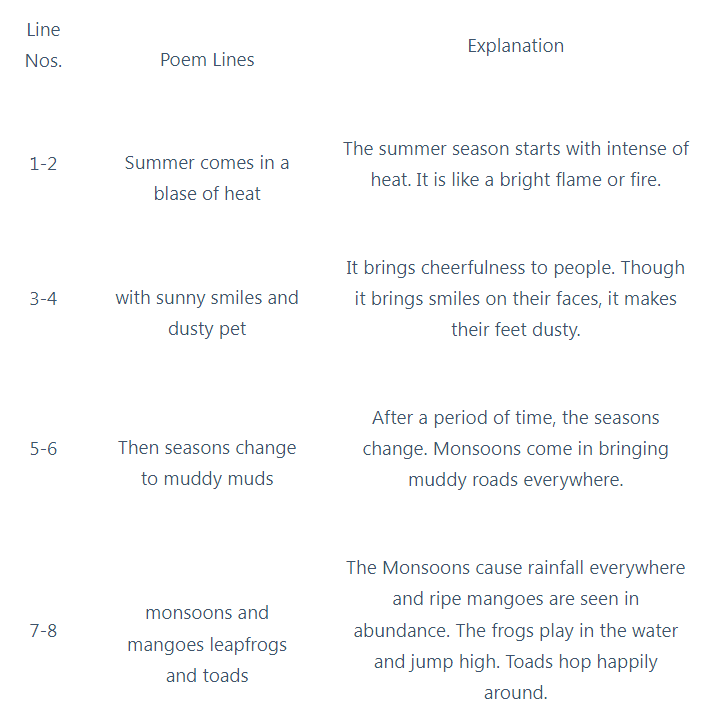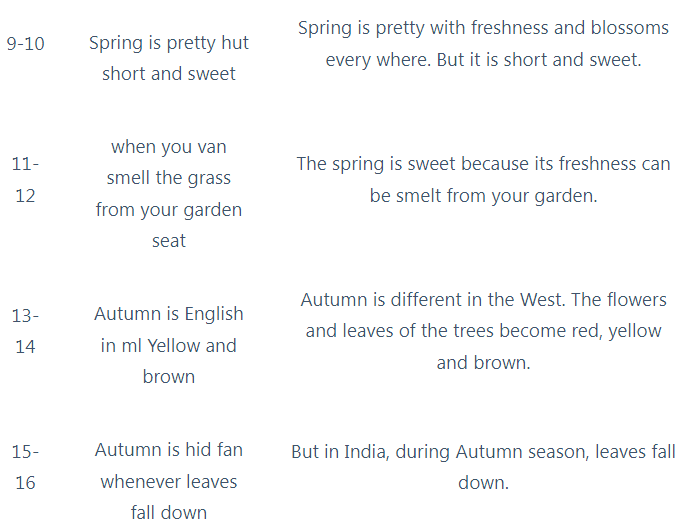Text Book Back Questions and Answers - Chapter 1 Indian Seasons Term 3 6th English Poem Guide Samacheer Kalvi Solutions - SaraNextGen [2024-2025]
Updated By SaraNextGen
On April 24, 2024, 11:35 AM
Samacheer Kalvi 6th English Solutions Term 3 Poem Chapter 1 Indian Seasons - Text Book Back Questions and Answers
Poem Overview


B. Which season am I? Read the poem, understand and solve the riddle.
- I make the feet dusty.
- Frogs and toads will visit when I am there.
- I am pretty short and sweet.
- I make your garden smell sweet.
- Leaves will wither because of me.
Answers:
- Summer
- Rainy
- Spring
- Spring
- Autumn
Read and Understand
C. Read the tines and answer the questions given below.
1. Summer comes
in a blaze of heat with
sunny smiles
and dusty feet
Question a.
Dots the poet welcome the summer? How do you know?
Answer:
Yes, the poet welcomes the summer because she says that summer comes with sunny smiles, making people cheerful.
Question b.
Which lines tells you that there is no rain in summer?
Answer:
‘Sunny smiles and dusty feet’ tells us that there is no rain in summer.
2. Spring is pretty
but short and sweet
when you can smell the grass
from your garden seat
Question a.
How does the poet describe the spring season?
Answer:
The poet describes the spring season as pretty, short and sweet.
Question b.
Which line tells you that the garden is fresh?
Answer:
The line ‘when you can smell the grass from your garden seat’ tells us that the garden is fresh.
Question c.
Who does ‘you’ refer to?
Answer:
‘You’ refers to ‘the person who owns the garden’.
3. Autumn is English
in red, yellow and brown
Autumn is Indian
Whenever leaves fell down
Question a.
How Is autumn in India?
Answer:
Whenever the leaves fall down, it is autumn in India.
Question b.
Compare the English autumn with the Indian autumn.
Answer:
The leaves are beautiful with red, yellow and brown colours and the poet considers this to be English autumn. Whenever the leaves fall down, it is Indian autumn.
D. Pick out the rhyming words from the poem and write them In the table.

E. Find examples of alliteration and write them in the blanks.
1. In a blaze of heat
with sunny smiles
Answer:
sunny – smiles
2. to muddy roads
monsoons and mangoes
Answer:
monsoons – mangoes
3. Spring Is pretty
but short and sweet
Answer:
short – sweet
F. Work In pairs, find answers for the questions and share In the class.
Question 1.
Name the seasons mentioned In the poem?
Answer:
The seasons mentioned in the poem are summer, rainy, spring and autumn.
Question 2.
What does the summer bring?
Answer:
The summer brings sunny smiles and dusty feet.
Question 3.
Which word refers to ‘rain’?
Answer:
The word ‘Monsoon’ refers to ‘rain’.
Question 4.
Why does the poet say the ‘Spring Is pretty’?
Answer:
The spring is pretty because we can smell the freshness of grass from our garden.
Question 5.
When Is it autumn in India? Why does the poet say this? Is there an autumn season in India?
Answer:
When the leaves fall down, it is autumn in India. The poet says this because in India, leaves rarely change colours. Only when the trees shed their leaves, we know that it is autumn in India. Yes, there is an autumn season in India during the months of September, October and November.
G. How does the poet describe the Indian seasons? Write in your own words in about 50 words.
Answer:
The poet describes the Indian seasons vividly in a simple form. The sumer season starts with intense heat. It is like a bright flame or fire. It brings cheerfulness to people and makes their feet dusty. Then, the seasons change. Monsoons come in bringing muddy roads, ripe mangoes, leaping frogs and toads everywhere. Spring is pretty but short. It is also sweet because we can smell the freshness of green grass from our garden. The poet compares the autumn season in the West to India. Leaves change their colours into red, yellow and brown in the West, whereas the trees shed their leaves in India.
Additional Questions
I. Poem Comprehension and Poetic Devices.
1. Then seasons change
to muddy roads
monsoons and mangoes
leapfrogs and toads
Question a.
What Is the season mentioned here?
Answer:
Rainy season is mentioned here.
Question b.
Why are roads muddy?
Answer:
The roads become muddy because of heavy rains.
Question c.
What do you mean by the word ‘leap’?
Answer:
‘Leap’ means ‘jump’.
Question d.
Pick out the alliterated words in third line.
Answer:
‘monsoons and mangoes’are the alliterated words.
Indian Seasons Poem 6th Standard Paragraph Question.
Question 1.
What do you know about spring season? What does it symbolize? Write in your own words.
Answer:
Trees and bushes that lose their leaves over the winter, begin to grow new leaves again and also flower in spring. This happens because the temperature of the air and soil starts to warm up and the hours of daylight increase, as the days get longer with the coming of spring. Spring symbolizes new life. So plants start to grow again and flowers appear.
Indian Seasons Poem Summary By Nisha Dyrene
The poet Nisha Dyrene in this poem ‘Indian seasons’ describes the four seasons prevalent in India. The poem begins with the summer season starting with intense heat. It comes like a bright flame or fire. It brings cheerfulness to people and makes their feet dusty. Then the seasons change, after a certain period of time. The roads become muddy at the onset of monsoons, which is a rainy season. We can see ripe mangoes everywhere. The frogs play in the water and jump high, where as the toads hop happily.
Next comes the spring season which is pretty, but its duration is short. It is also sweet because you can smell fresh grass from your garden. The poet compares autumn in the West to autumn in India. She says when the leaves are red, yellow and brown, then it signifies autumn in the West. But when the leaves shed, it is autumn in India
Also Read : Text-Book-Back-Questions-and-Answers-Chapter-2-A-Tragic-Story-Term-3-6th-English-Poem-Guide-Samacheer-Kalvi-Solutions
